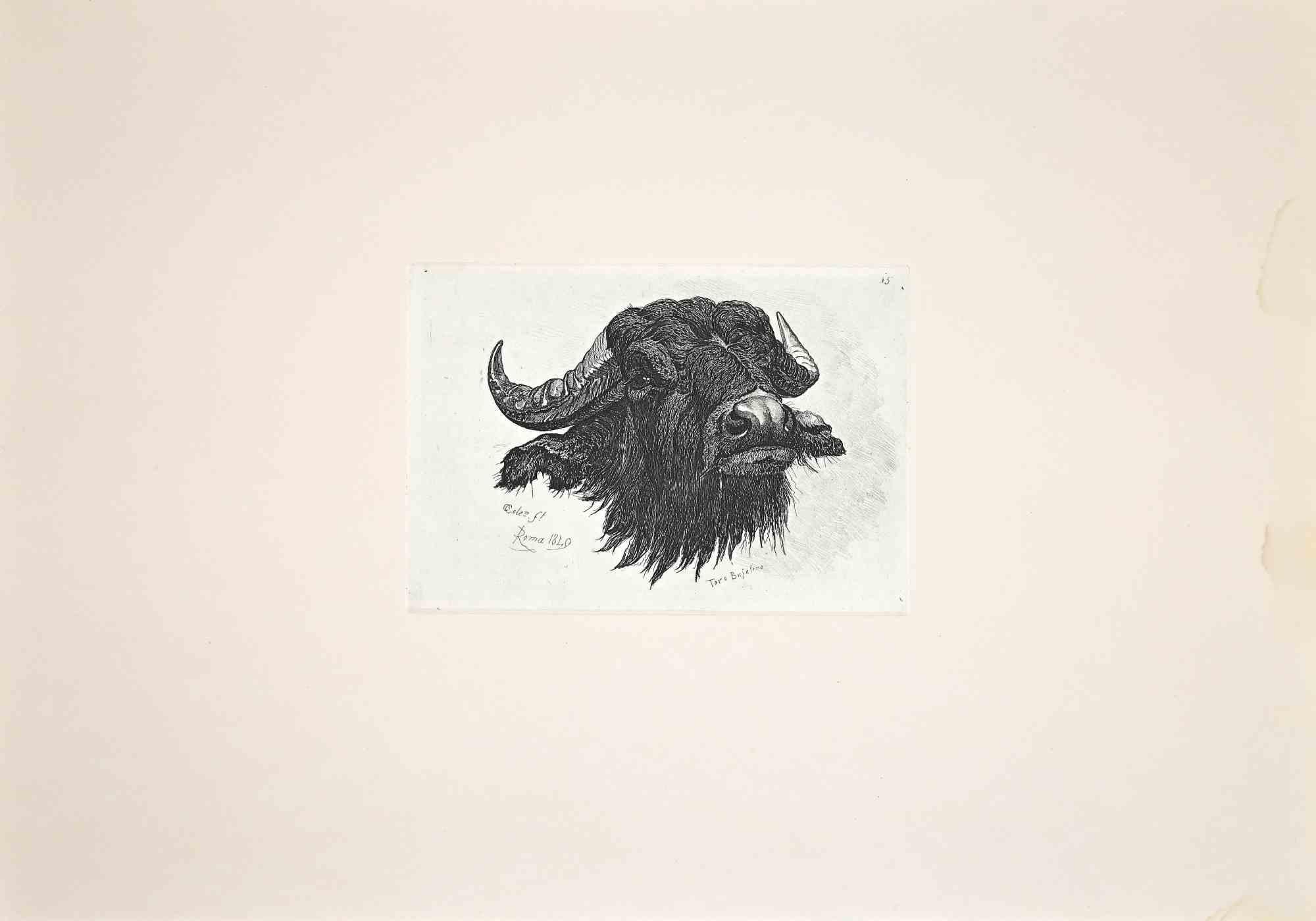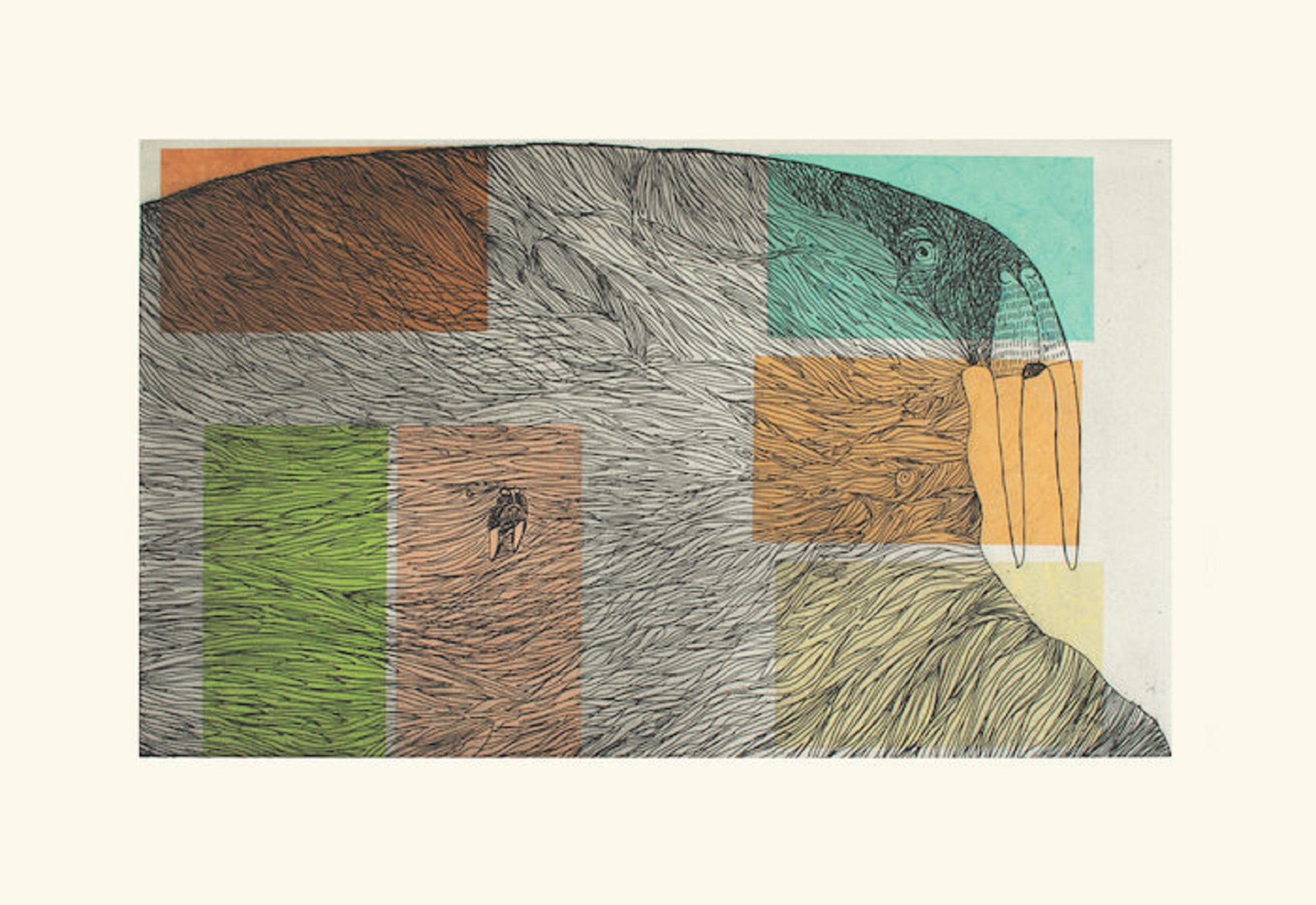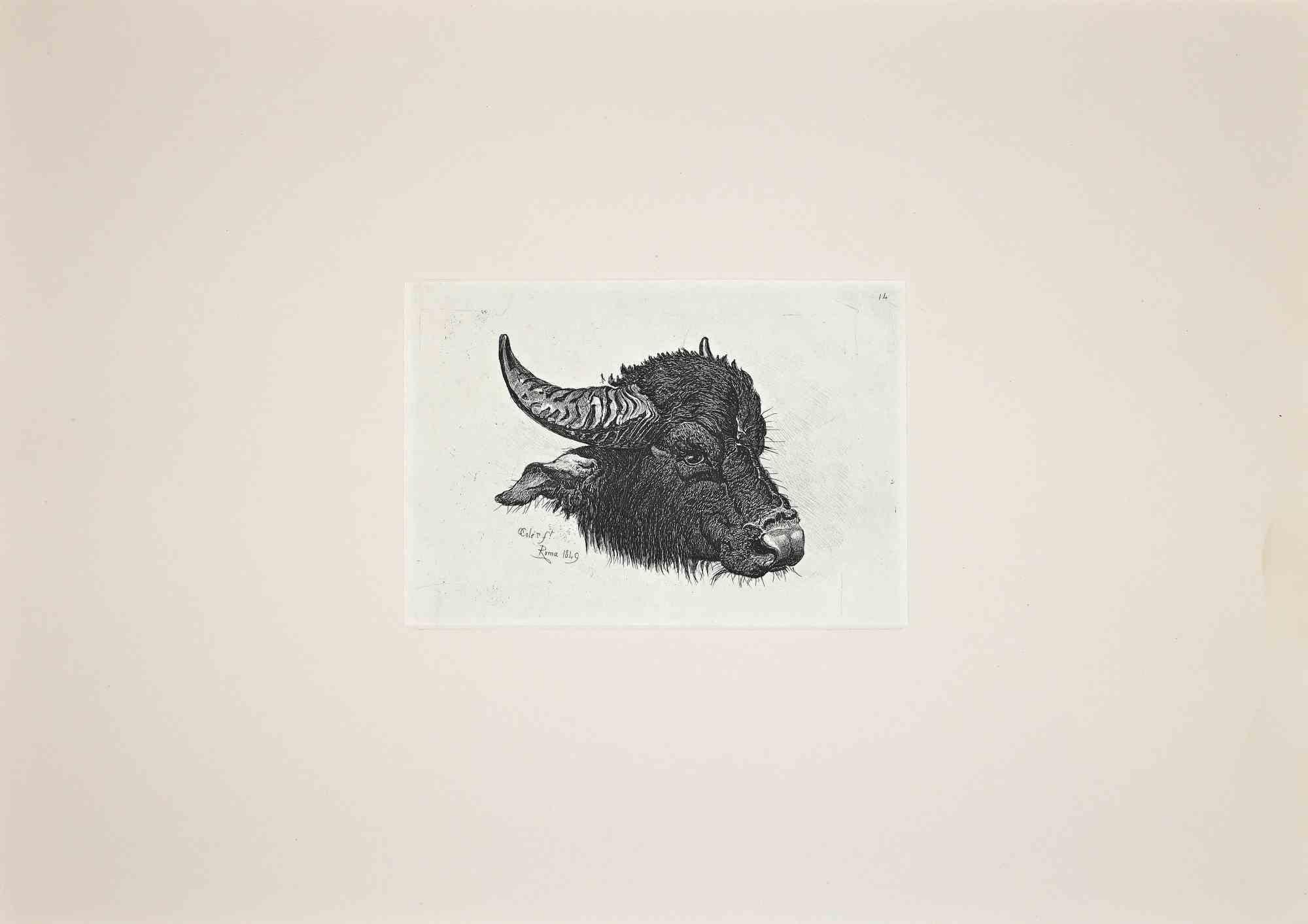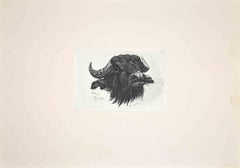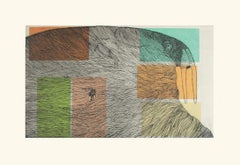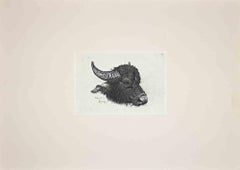Items Similar to Aggressive Muskox
Want more images or videos?
Request additional images or videos from the seller
1 of 11
Pudlo PudlatAggressive Muskox1984
1984
$1,600
£1,203.07
€1,397.06
CA$2,234.37
A$2,478.08
CHF 1,301.36
MX$30,432.56
NOK 16,474.04
SEK 15,535.24
DKK 10,423.58
Shipping
Retrieving quote...The 1stDibs Promise:
Authenticity Guarantee,
Money-Back Guarantee,
24-Hour Cancellation
About the Item
This artwork titled "Aggressive Muskox" 1984 is an original color etching with aquatint on Wove paper by noted Canadian/Inuit artist Pudlo Pudlat, 1916-1992. It is hand signed, titled, dated. described, located and numbered 1/25 in pencil by the artist. The plate mark (image) size is 8 x 9.75 inches, framed size is 16.5 x 18.35 inches. Custom framed in a metal gold frame, with light brown fabric matting. it is in excellent condition.
About the artist:
Pudlo Pudlat, graphic artist (born 4 February 1916 in Kamadjuak Camp, Baffin Island, NWT; died 28 December 1992 in Cape Dorset, NWT). One of the most original contemporary Inuit artists, Pudlo Pudlat included in his imagery icons of the modern technology that has brought such profound changes to the Canadian North. Working in a combination of acrylic wash and coloured pencils, at his death he had completed 4,500 drawings, around 200 of which had been turned into prints, and several sculptures.
Until Pudlo was six years old, he and his family lived near Coral Harbour and later moved to the Lake Harbour region, now called Kimmirut. Until he was in his 40s, he lived as a semi-nomadic hunter and fisherman, travelling along the southwest coast of Baffin Island. In the late 1950s, Pudlo moved to Kiaktuuq, near Cape Dorset, in order to recover from tuberculosis. It was there that he met James Houston, founding director of the West Baffin Eskimo Co-operative, and began making art. Encouraged by Houston and then by Houston’s successor, Terry Ryan, he started out carving, but found it difficult because of an arm injury and switched to drawing in 1959 or 1960. Eventually, Pudlo practiced printmaking, painting with acrylic paint and drawing with graphite pencils, coloured pencils and felt-tip markers.
Pudlo was in a unique position to witness the transformations of traditional Inuit life in the 1950s, from a semi-nomadic lifestyle to a settled one, and also by the introduction of modern technology into the Arctic. This transformation is depicted in his art. In Pudlo’s work, airplanes, helicopters and telephone poles enter into strange interactions with the Arctic landscape and its animals. A muskox rider lassoing an airplane or a loon steering a motorboat are examples of his juxtapositions. In many ways Pudlo's work symbolizes the paradoxes of the encounter between Inuit and Western culture. In an untitled painting from the 1980s, for instance, there is a cluster of simple houses in the foreground; in the middle ground there is a telephone pole and an antenna set on immense boulders, and along the treeless horizon are two hunters dark and barely discernible, wielding spears and knives. Above it all are two jets amidst the sky and blue clouds. The painting partly illustrates a strange surrealism that occurs when the traditional lifestyle of the Inuit is set in the context of modern technologies and amenities. In the colour drawing from 1990, Old and New, hunters in canoes paddle across the water toward a gigantic goose surrounded by her goslings, a jet swooping above them. In Old and New what one most notices is not just the comically huge goose but the almost comic difference in scale between modern technologies, the natural world and human beings.
Pudlo Pudlat’s works are in the collections of most Canadian museums, including the National Gallery of Canada, and some international institutions. His art has been featured in solo exhibition across Canada, the United States and Europe. In 1990, the National Gallery of Canada organized a retrospective exhibition of his drawings, Pudlo: Thirty Years of Drawing, and mounted another major exhibition, Pudlo Pudlat: A Celebration, in 1993. In the same year, there was a solo exhibition of his work, Pudlo Pudlat: A Meeting of Cultures, at the McMichael Canadian Art Collection.
- Creator:Pudlo Pudlat (1916 - 1992, Canadian)
- Creation Year:1984
- Dimensions:Height: 16.5 in (41.91 cm)Width: 18.35 in (46.61 cm)Depth: 0.65 in (1.66 cm)
- Medium:
- Period:
- Condition:
- Gallery Location:San Francisco, CA
- Reference Number:Seller: pud/agr/mus/011stDibs: LU666311035692
About the Seller
5.0
Platinum Seller
Premium sellers with a 4.7+ rating and 24-hour response times
Established in 1999
1stDibs seller since 2017
805 sales on 1stDibs
Typical response time: 1 hour
- ShippingRetrieving quote...Shipping from: San Francisco, CA
- Return Policy
Authenticity Guarantee
In the unlikely event there’s an issue with an item’s authenticity, contact us within 1 year for a full refund. DetailsMoney-Back Guarantee
If your item is not as described, is damaged in transit, or does not arrive, contact us within 7 days for a full refund. Details24-Hour Cancellation
You have a 24-hour grace period in which to reconsider your purchase, with no questions asked.Vetted Professional Sellers
Our world-class sellers must adhere to strict standards for service and quality, maintaining the integrity of our listings.Price-Match Guarantee
If you find that a seller listed the same item for a lower price elsewhere, we’ll match it.Trusted Global Delivery
Our best-in-class carrier network provides specialized shipping options worldwide, including custom delivery.More From This Seller
View AllWinter Dream
By Pudlo Pudlat
Located in San Francisco, CA
This artwork titled "Winter Dream" 1989 is an original stonecut on thin tissue paper by noted Canadian/Inuit artist Pudlo Pudlat, 1916-1992. It is hand signed, titled, dated. describ...
Category
Late 20th Century Other Art Style Animal Prints
Materials
Other Medium
Elephant Man
By Charles Bragg
Located in San Francisco, CA
This artwork titled "Elephant Man" c.1985 is an original color lithograph by noted American artist Charles Bragg, 1931-2017. It is hand signed and numbere...
Category
Late 20th Century Other Art Style Figurative Prints
Materials
Lithograph
Intrepid Caribou
Located in San Francisco, CA
This artwork titled "Intrepid Caribou" 2002 is an original color stone cut on Japan paper by noted Canadian/Inuit artist Kananginak Pootoogook, 1935-2010. It is hand signed, dated, titled, located, described and numbered 22/50 in pencil by the artist. The image size is 18.5 x 12.5 inches, sheet size is 23 x 16 inches, framed size is 24.85 x 29.65 inches. Custom framed in a black metal frame, with black matting. It is in excellent condition.
About the artist:
Kananginak Pootoogook was an Inuit sculptor and printmaker who lived in Cape Dorset, Nunavut, in Canada. He died as a result of complications related to surgery for lung cancer.
Pootoogook was born at a traditional Inuit camp called Ikerasak, near Cape Dorset, Nunavut (then in the Northwest Territories) to Josephie Pootoogook, leader of the camp, and Sarah Ningeokuluk. The family lived a traditional lifestyle hunting and trapping while living in an iglu in the winter and a sod house in the summer and did not move into their first southern style house until 1942. In 1957 Pootoogook married Shooyoo, moved to Cape Dorset and began work for James Houston.
Originally, Pootoogook did some carving, made prints and lithographs for other artists. At the same time he was a leader in setting up the West Baffin Eskimo Co-operative, the first Inuit owned co-op, now part of the Arctic Co-operatives Limited and served from 1959 until 1964 as the president. Although Kananginak had worked with his father, Josephie, in 1959, it was not until the 1970s that Kananginak began work as a full-time artist producing drawings, carvings and prints. According to Terry Ryan, former Co-op manager, Pootoogook was both influenced by and an admirer of the works of his uncle, photographer and historian Peter Pitseolak.
The World Wildlife Commission released a limited edition set in 1977 that included four of Pootoogook's images and in 1980 he was elected to the Royal Canadian Academy of Arts. In 1997 Pootoogook built a 6 ft (1.8 m) inukshuk in Cape Dorset for former Governor General of Canada, Roméo LeBlanc. The inukshuk was dismantled and shipped to Ottawa and with the assistance of his son, Johnny, it was rebuilt at Rideau Hall and unveiled on 21 June, National Aboriginal Day.
Pootoogook had several exhibitions and showings of his work. In 2010, he went to Vancouver for the 2010 Winter Olympics and to open a showing of his work at the Marion Scott Gallery. He also had a showing of his work, his first solo exhibition at a public institution, at the Museum of Inuit Art in Toronto from February to May 2010. He also received a 2010 National Aboriginal Achievement Award in the arts category from the National Aboriginal Achievement Foundation.
While working on his final, and unfinished, drawing of a Peterhead owned by his father, he was struck by coughing spells, which he declared was cancer. Along with his wife, Shooyoo, he flew to Ottawa, staying at the Larga Baffin home, and was diagnosed with lung cancer. In October 2010, he underwent surgery and did not recover. He died 23 November 2010 in Ottawa. The work of Kananginak Pootoogook is held in numerous collections and museums, includingThe McCord Museum, the Dallas Museum of Art, Musee National des Baux Arts...
Category
Late 20th Century Other Art Style Figurative Prints
Materials
Other Medium
Price Upon Request
The Protectress
Located in San Francisco, CA
This artwork titled "The protectress" 1997 is a original stone cut with stencil on thin paper by noted Canadian Inuit artist Kakulu Saggiaktok, 1940-...
Category
Late 20th Century Other Art Style Animal Prints
Materials
Stencil
Silent Hunter
Located in San Francisco, CA
This artwork titled "Silent Hunter" 2002 is an original color stonecut on beige Japan paper by noted Canadian/Inuit artist Kananginak Pootoogook, 1935-2010. It is hand signed, dated, titled, located, described and numbered 22/50 in pencil by the artist. The image size is 15 x 11.75 inches, framed size is 23.35 x 20 inches. Custom framed in a wooden dark green frame, with green matting. It is in excellent condition.
About the artist:
Kananginak Pootoogook was an Inuit sculptor and printmaker who lived in Cape Dorset, Nunavut, in Canada. He died as a result of complications related to surgery for lung cancer.
Pootoogook was born at a traditional Inuit camp called Ikerasak, near Cape Dorset, Nunavut (then in the Northwest Territories) to Josephie Pootoogook, leader of the camp, and Sarah Ningeokuluk. The family lived a traditional lifestyle hunting and trapping while living in an iglu in the winter and a sod house in the summer and did not move into their first southern style house until 1942. In 1957 Pootoogook married Shooyoo, moved to Cape Dorset and began work for James Houston.
Originally, Pootoogook did some carving, made prints and lithographs for other artists. At the same time he was a leader in setting up the West Baffin Eskimo Co-operative, the first Inuit owned co-op, now part of the Arctic Co-operatives Limited and served from 1959 until 1964 as the president. Although Kananginak had worked with his father, Josephie, in 1959, it was not until the 1970s that Kananginak began work as a full-time artist producing drawings, carvings and prints. According to Terry Ryan, former Co-op manager, Pootoogook was both influenced by and an admirer of the works of his uncle, photographer and historian Peter Pitseolak.
The World Wildlife Commission released a limited edition set in 1977 that included four of Pootoogook's images and in 1980 he was elected to the Royal Canadian Academy of Arts. In 1997 Pootoogook built a 6 ft (1.8 m) inukshuk in Cape Dorset for former Governor General of Canada, Roméo LeBlanc. The inukshuk was dismantled and shipped to Ottawa and with the assistance of his son, Johnny, it was rebuilt at Rideau Hall and unveiled on 21 June, National Aboriginal Day.
Pootoogook had several exhibitions and showings of his work. In 2010, he went to Vancouver for the 2010 Winter Olympics and to open a showing of his work at the Marion Scott Gallery. He also had a showing of his work, his first solo exhibition at a public institution, at the Museum of Inuit Art in Toronto from February to May 2010. He also received a 2010 National Aboriginal Achievement Award in the arts category from the National Aboriginal Achievement Foundation.
While working on his final, and unfinished, drawing of a Peterhead owned by his father, he was struck by coughing spells, which he declared was cancer. Along with his wife, Shooyoo, he flew to Ottawa, staying at the Larga Baffin home, and was diagnosed with lung cancer. In October 2010, he underwent surgery and did not recover. He died 23 November 2010 in Ottawa. The work of Kananginak Pootoogook is held in numerous collections and museums, includingThe McCord Museum, the Dallas Museum of Art, Musee National des Baux Arts...
Category
Late 20th Century Other Art Style Figurative Prints
Materials
Other Medium
Two Oxen
By Nevzat Akoral
Located in San Francisco, CA
This artwork "Two Oxen" c.1960 is an original linocut on thin fiber paper by noted Turkish artist Nevzat Akoral, 1926-2016 It is signed in the plate as issue. The image is 11.15 x 9....
Category
Mid-20th Century Realist Animal Prints
Materials
Linocut
You May Also Like
The Buffalo - Etching After Charles Coleman - 1992
Located in Roma, IT
The Buffalo is an original etching artwork realized after Charles Coleman (1807, Yorkshire - 1874, Roma) in 1992.
Signed on the plate. The rare editio...
Category
1990s Modern Animal Prints
Materials
Etching
Ancestral Walrus
Located in Whistler, CA
Since her first prints appeared in the collection in 2004, Ningiukulu has been one of Kinngait’s studio’s most celebrated artists. She has a comprehensive knowledge of Inuit legends ...
Category
2010s Contemporary Abstract Drawings and Watercolors
Materials
Etching
The Buffalo - Etching After Charles Coleman - 1992
Located in Roma, IT
The Buffalo is an original etching artwork realized after Charles Coleman (1807, Yorkshire - 1874, Roma) in 1992.
Signed on the plate. The rare editio...
Category
1990s Modern Animal Prints
Materials
Etching
Black Bull
By Gabor F. Peterdi
Located in Long Island City, NY
Artist: Gabor Peterdi, Hungarian (1915 - 2001)
Title: Black Bull
Year: 1962
Medium: Etching, signed, titled and numbered in pencil
Edition: HC 10
Image Size...
Category
1960s American Modern Animal Prints
Materials
Etching
The Buffalo - Etching After Charles Coleman - 1992
Located in Roma, IT
The Buffalo is an original etching artwork realized after Charles Coleman (1807, Yorkshire - 1874, Roma) in 1992.
Signed on the plate. The rare editio...
Category
1990s Modern Animal Prints
Materials
Etching
RAM
By Jacques Hnizdovsky
Located in Portland, ME
Hnizdosvsky, Jacques. RAM. Tahir 370. Etching, 1979. Edition of 150.
Signed, Titled, dated and numbered 59/100, all in pencil. 16 3/4 x 23 inches In excellent
condition. Framed.
Category
1970s Animal Prints
Materials
Etching
More Ways To Browse
Inuit Art
Painted Paddle
Goose Sculpture
Canadian Inuit Art
Vintage Airplane Painting
Canoe Sculpture
1950s Telephone
Eskimo Vintage
Vintage Airplane Sculpture
Eskimo Prints
Canada Goose
Inuit Art Prints
Fisherman Etching
Vintage Inuit Carvings
Used Canoe Paddles
Eskimo Sculpture
Old Used Canoe
Eskimo Carvings Vintage
